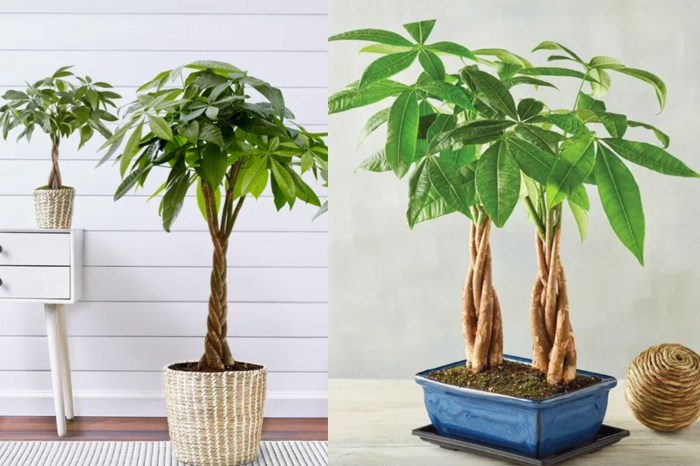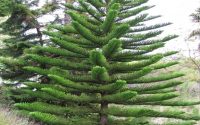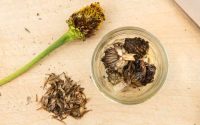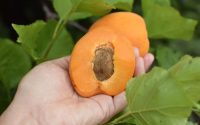The Money Tree Plant Care Guide
Introduction to the Money Tree Plant

The money tree plant care – The Pachira aquatica, more commonly known as the money tree, is a captivating houseplant prized for its unique appearance and purported good fortune. Originating in the swamps and wetlands of Central and South America, this plant boasts a striking visual appeal that has made it a popular choice for homes and offices worldwide. Its enduring popularity stems from a combination of its aesthetic qualities and the relatively low-maintenance care it requires.The money tree’s distinctive feature is its braided trunk, often composed of several stems intricately woven together.
This braiding is typically done when the plant is young, creating a visually appealing and somewhat symbolic element. The leaves are palmate, meaning they radiate from a central point, resembling a hand with five to seven leaflets. These glossy, dark green leaves add to the plant’s overall lush and vibrant appearance. Mature money trees can grow quite tall, reaching heights of up to 60 feet in their natural habitat, although they remain considerably smaller when grown indoors.
Money Tree’s Popularity as a Houseplant, The money tree plant care
The money tree’s popularity as a houseplant is multifaceted. Its visually appealing braided trunk is a significant factor, adding an element of unique style to any interior. The relatively easy care requirements make it an accessible option for both experienced and novice plant owners. Furthermore, the plant is associated with good luck and prosperity in several cultures, adding a symbolic layer to its appeal.
This association, combined with its relatively low maintenance needs and attractive appearance, makes the money tree a consistently sought-after houseplant. The plant’s ability to thrive in low-light conditions further enhances its suitability for indoor environments, where direct sunlight may be limited.
Watering Techniques for Money Tree Plants
Proper watering is crucial for a thriving money tree. Overwatering leads to root rot, while underwatering results in wilting and leaf drop. Mastering the art of watering your money tree involves understanding its needs, recognizing signs of distress, and developing a consistent routine. This section will guide you through the process, ensuring your money tree receives the perfect amount of hydration.
The key to successful money tree watering is to avoid both extremes – soggy soil and bone-dry conditions. Money trees prefer consistently moist, but not waterlogged, soil. The frequency of watering depends on several factors, including pot size, soil type, temperature, and humidity. A larger pot will retain moisture longer than a smaller one, while well-draining soil will dry out faster than heavy clay soil.
Warmer temperatures and lower humidity increase the rate of evaporation, requiring more frequent watering.
Determining When to Water a Money Tree
Knowing when to water is paramount. Avoid a strict schedule; instead, rely on observable signs. Insert your finger about 2-3 inches into the soil. If the soil feels dry to the touch, it’s time to water. Another effective method involves weighing the pot.
A lighter pot indicates dry soil, signaling the need for watering. Observe the leaves; slightly drooping leaves might indicate the need for water, but severe drooping suggests potential overwatering problems.
Signs of Overwatering and Underwatering
Overwatering manifests as yellowing leaves, leaf drop, and a mushy or foul-smelling soil. The plant may appear sluggish and its growth stunted. Root rot, a serious condition caused by excessive moisture, may develop. Underwatering, on the other hand, leads to dry, brittle leaves that curl and wilt. The soil will feel completely dry to the touch.
Step-by-Step Guide to Watering a Money Tree Plant
Follow these steps for consistent and effective watering:
- Check the Soil Moisture: Insert your finger 2-3 inches into the soil. If it feels dry, proceed to watering.
- Water Thoroughly: Water the plant until water drains from the drainage holes at the bottom of the pot. This ensures the entire root system is moistened.
- Remove Excess Water: Empty any water that collects in the saucer or cache pot beneath the plant’s pot. Standing water can lead to root rot.
- Allow Soil to Dry Slightly Between Waterings: Don’t water again until the top few inches of soil feel dry to the touch. This prevents overwatering.
- Adjust Watering Based on Environmental Conditions: Increase watering frequency during hot, dry periods and decrease it during cooler, more humid times.
Soil and Potting Considerations
The right soil and pot are crucial for a thriving money tree. Choosing the wrong combination can lead to root rot, stunted growth, or even plant death. Understanding the ideal soil composition and pot size will significantly impact your money tree’s health and longevity. Let’s delve into the specifics.
Suitable Potting Mixes for Money Trees
Money trees prefer well-draining soil that prevents waterlogging. Heavy clay soils retain too much moisture, leading to root problems. A loose, airy mix is key. Commercial potting mixes often contain peat moss, perlite, and vermiculite, which provide excellent drainage and aeration. However, many commercial mixes can be improved upon.
Adding extra perlite or coarse sand will further enhance drainage. You can also create your own custom blend.
Importance of Proper Drainage
Proper drainage is paramount for money tree health. Standing water suffocates roots, depriving them of oxygen and creating an environment ripe for fungal diseases and root rot. Ensure your pot has drainage holes to allow excess water to escape. A layer of gravel or broken pottery shards at the bottom of the pot further enhances drainage by preventing the soil from compacting and blocking the drainage holes.
Without proper drainage, your money tree will struggle to thrive.
Ideal Pot Size and Material for Healthy Growth
Choosing the right pot size is crucial. A pot that’s too small will restrict root growth, while one that’s too large can lead to overwatering and root rot. Start with a pot that’s only slightly larger than the root ball. As the plant grows, you can repot it into a larger container. Terracotta pots are generally preferred for money trees due to their porous nature, which allows for better air circulation and prevents water retention.
However, plastic pots are also suitable, provided they have adequate drainage holes.
Comparison of Different Potting Mixes
Different potting mixes offer varying benefits and drawbacks for money trees. The ideal mix balances drainage, aeration, and water retention. Here’s a comparison:
| Potting Mix | Pros | Cons |
|---|---|---|
| Commercial Potting Mix (Peat, Perlite, Vermiculite) | Readily available, generally well-draining | Can become compacted over time, may require amendments |
| Custom Mix (Potting Soil, Perlite, Coarse Sand) | Highly customizable to specific needs, excellent drainage | Requires more effort to create |
| Cactus and Succulent Mix | Excellent drainage, designed for plants that need less water | May be too dry for money trees if not amended with other components |
Fertilizing and Nutritional Needs: The Money Tree Plant Care

Money trees, while relatively low-maintenance, still benefit from regular fertilization to maintain their vibrant green foliage and robust growth. Providing the right nutrients at the right time ensures your money tree thrives and avoids common deficiencies. Over-fertilizing, however, can be just as detrimental as under-fertilizing, so a balanced approach is key.
The type and frequency of fertilization depend on several factors, including the time of year, the type of fertilizer used, and the overall health of your plant. Generally, money trees appreciate a slow-release, balanced fertilizer, as this mimics the gradual nutrient release found in natural environments. Avoid fertilizers high in nitrogen, as this can lead to leggy growth and weak stems.
Signs of Nutrient Deficiencies
Nutrient deficiencies in money trees often manifest as visible changes in the plant’s appearance. Yellowing leaves, especially older leaves, can indicate a lack of nitrogen or other essential micronutrients. Brown leaf tips or edges may signal problems with potassium or magnesium. Stunted growth or an overall lack of vigor could suggest a broader nutritional imbalance. Early identification and correction are crucial for preventing further damage and restoring the plant’s health.
Careful observation of your money tree’s leaves and growth patterns will help you detect these signs early.
Adjusting Fertilizer Application Based on Season
Money trees are actively growing during the warmer months (spring and summer), requiring more frequent fertilization. During the dormant period (fall and winter), their growth slows significantly, and their nutritional needs decrease accordingly. Therefore, adjusting the fertilizer schedule based on the season ensures you provide the appropriate amount of nutrients without overfeeding during periods of low growth. Over-fertilizing during dormancy can build up salts in the soil, harming the roots.
Money Tree Fertilization Schedule
The following schedule provides a guideline for fertilizing your money tree throughout the year. Remember to always follow the instructions on your chosen fertilizer product. Adjust the amount and frequency based on your plant’s specific needs and observations.
| Season | Fertilizer Type | Frequency | Amount |
|---|---|---|---|
| Spring | Balanced, slow-release liquid fertilizer (e.g., 10-10-10) | Every 2-3 weeks | Half-strength solution |
| Summer | Balanced, slow-release liquid fertilizer (e.g., 10-10-10) | Every 2-3 weeks | Half-strength solution |
| Autumn | Balanced, slow-release liquid fertilizer (e.g., 10-10-10) | Every 4-6 weeks | Quarter-strength solution |
| Winter | No fertilizer | None | None |
Common Problems and Their Solutions
Money tree plants, while relatively low-maintenance, can still encounter several issues. Understanding these problems and their solutions is key to maintaining a healthy and thriving plant. Ignoring early warning signs can lead to more significant problems, so proactive monitoring is crucial. This section details common money tree ailments, their causes, and effective remedies.
Leaf Drop
Leaf drop in money trees can stem from various factors, often indicating stress. Overwatering, underwatering, temperature fluctuations, or insufficient light are all potential culprits. Addressing the underlying cause is crucial for preventing further leaf loss and promoting new growth.
- Problem: Excessive leaf drop, often starting with lower leaves.
- Cause: Overwatering, leading to root rot; underwatering, causing dehydration; drastic temperature changes; insufficient light.
- Solution: Check the soil moisture; adjust watering frequency accordingly. Ensure the pot has adequate drainage. Relocate the plant to a warmer location (avoid drafts) and provide brighter, indirect light.
- Preventative Measures: Use well-draining soil, water only when the top inch of soil is dry, and maintain consistent temperature and light levels.
Yellowing Leaves
Yellowing leaves, another common problem, often points to nutrient deficiencies or overwatering. The specific pattern of yellowing can offer clues to the underlying cause. For example, yellowing between the leaf veins might indicate a nutrient deficiency, while overall yellowing might suggest overwatering.
Nurturing your money tree requires understanding its needs, just like any other thriving plant. Proper spacing is crucial for healthy growth, and this principle extends beyond just your indoor money tree; consider the vital information on how far to plant fruit trees apart to grasp the importance of giving plants ample room. Applying this broader perspective to your money tree, ensure it has sufficient space to flourish, maximizing its potential for growth and prosperity.
- Problem: Yellowing of leaves, potentially accompanied by leaf drop.
- Cause: Overwatering, leading to root rot and nutrient deficiencies; insufficient fertilization; lack of essential nutrients like iron or nitrogen.
- Solution: Check soil moisture; adjust watering. Fertilize according to the plant’s needs (using a balanced liquid fertilizer diluted to half strength). Consider a soil test to determine specific nutrient deficiencies.
- Preventative Measures: Use well-draining soil, water only when necessary, and fertilize regularly during the growing season (spring and summer).
Pests
Money trees can be susceptible to common houseplant pests like mealybugs, spider mites, and aphids. Early detection and treatment are essential to prevent infestations from spreading and damaging the plant.
- Problem: Visible insects on leaves and stems, webbing, sticky residue.
- Cause: Infestation of mealybugs, spider mites, aphids, or other pests.
- Solution: Isolate the infected plant. Treat with insecticidal soap, neem oil, or a suitable systemic insecticide following product instructions carefully. Manually remove visible pests with a cotton swab dipped in rubbing alcohol.
- Preventative Measures: Regularly inspect the plant for signs of pests. Maintain good hygiene, wiping down leaves occasionally. Introduce beneficial insects like ladybugs if the infestation is severe.
Maintaining the Appearance of the Money Tree
A thriving money tree isn’t just about healthy growth; it’s about cultivating a visually appealing plant that enhances your home or office. Regular maintenance, including pruning, cleaning, and environmental control, significantly impacts its aesthetic appeal and overall health. By following these techniques, you can ensure your money tree remains a beautiful and vibrant addition to your space.
Pruning and Shaping the Money Tree
Pruning your money tree is essential for maintaining its shape and promoting bushier growth. Overgrown or leggy branches can detract from its aesthetic appeal. The best time to prune is during the spring or summer months when the plant is actively growing. Use sharp, clean pruning shears to make clean cuts just above a leaf node, encouraging new growth from that point.
Regularly removing dead or damaged leaves also improves the overall appearance and health of the plant. For instance, if a branch becomes excessively long and bare, pruning it back will encourage the growth of new, fuller branches. Careful pruning can transform a leggy plant into a lush, full specimen.
Regular Cleaning of the Money Tree
Dust accumulation on the leaves of your money tree can hinder photosynthesis and diminish its vibrant green color. Regular cleaning helps maintain its aesthetic appeal and overall health. Gently wipe the leaves with a damp cloth or sponge to remove dust and debris. Avoid using harsh chemicals or abrasive cleaners, which can damage the leaves. A weekly or bi-weekly cleaning, depending on your environment, will keep your money tree looking its best.
For example, in a dusty environment, more frequent cleaning might be necessary.
Maintaining the Plant’s Aesthetic Appeal
Beyond pruning and cleaning, maintaining the aesthetic appeal of your money tree involves several considerations. Rotating the plant regularly ensures even growth and prevents it from leaning towards a light source. This prevents the plant from becoming lopsided and maintains its symmetrical shape. Monitoring for pests and diseases is also crucial. Early detection and treatment prevent damage that can affect the plant’s appearance.
For instance, a spider mite infestation can cause leaf discoloration and webbing, significantly impacting the plant’s aesthetic appeal. Prompt treatment is essential to maintain its beauty.
Ideal Environment for a Vibrant Money Tree
The environment plays a significant role in maintaining the vibrant appearance of your money tree. Consistent, indirect sunlight is key. Direct sunlight can scorch the leaves, while insufficient light can lead to leggy growth. Maintaining a consistent temperature and humidity level also contributes to the plant’s overall health and aesthetic appeal. Money trees thrive in temperatures between 65°F and 75°F (18°C and 24°C) and prefer slightly higher humidity levels.
For example, placing the plant near a humidifier or grouping it with other plants can help increase humidity. A well-lit, consistently warm, and moderately humid environment will ensure your money tree remains a beautiful and healthy centerpiece.
Question Bank
Can I use tap water for my money tree?
It’s best to use filtered or distilled water, as tap water can contain minerals that may harm your plant over time. Let the water sit out for a day to allow chlorine to dissipate.
Why are my money tree leaves dropping?
Leaf drop can indicate overwatering, underwatering, insufficient light, or temperature fluctuations. Check your watering routine, lighting conditions, and ensure consistent temperatures.
How often should I repot my money tree?
Repotting is usually necessary every 1-2 years, or when the roots become root-bound. Choose a pot slightly larger than the previous one.
What are the signs of pest infestation in a money tree?
Look for small insects, sticky residue, or webbing on the leaves and stems. Regularly inspect your plant for early detection.
My money tree’s leaves are yellowing. What should I do?
Yellowing leaves can be due to overwatering, underwatering, nutrient deficiencies, or disease. Check your watering schedule, soil condition, and consider applying a balanced fertilizer.



